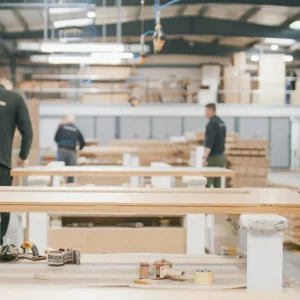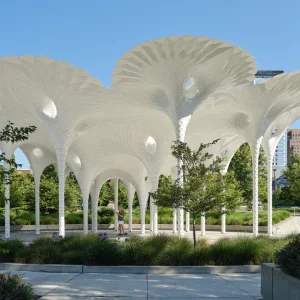In The Opposite House, Beijing, Swire Hotels and Japanese architect Kengo Kuma have created a hotel set around an atrium just waiting to be featured in the next Jackie Chan movie. Swaths of metallic mesh sweep down from the ceilings into the opening hall, pretty much asking Jackie to make an acrobatic escape down one of them. It wouldn’t be too much of problem either, as not much goes on in the Opposite House reception area; there’s no actual reception desk- the ‘paperless’ check-in is done by the staff (who must be borrowed from China’s Next Top Model) either in the Living Room or in the pick up car on the way over.
Without the focal point of a reception desk Kuma has created many other arresting features, such as the 6 metre high acrylic apothecary unit, a play on traditional Chinese furniture. It houses over 6000 drawers, some open, some don’t and if you’re lucky you will find one that has something left in there from a previous guest – anything ranging from a business card to a Tonka truck apparently.
It’s an example of how the Opposite House has tapped into the funky attitude of the surrounding Sunlitun area, perhaps the Soho, or dare I say Shoreditch, of Beijing. And the oversized cabinet marks the tone for the rest of the interior which references old China, and Kuma’s own home Japan, but throughout it gives a modern take on the traditions of the orient. The rooms themselves have the architect’s signature seamless, transparent style. If Muji made prefab bedrooms this is what they would be like, a clean lined box with a fresh white bed and little else! The huge oak tub is perfect for soaking in after all those steps at the Great Wall, or a day of hard-bargaining at the Silk market. Not for the shy, both the bath and the rain shower are located in the same space as the bedroom separated by a glass partition with an optional curtain, depending how long you have been dating your room mate.
The bareness of the feng shui-ed rooms is, of course, intentional. The 6-star Opposite House visitors already have plenty of ‘stuff’ so coming here is a break away from the cluttered life. And what they lack in stuff, they make up for in feel – the under-heated, reclaimed oak floor boards, and pure granite white walls give a sense of quiet, both physical and mentally. In fact, the whole place has a warm ambience, Beijing in the autumn is crisp to say the least, but stepping back into the hotel always felt like coming home.
Kengo’s design plan makes the most of the natural light and means that at night the place takes on a different vibe, with three different restaurants and two bars. Each one designed by Shanghai based team Neri and Hu, based on the Chinese Five elements theory. For example, Sureno restaurant has a large open stove as its centre piece (Fire) where as the Hoxton-style Punk nightclub is literally encased in a hole-punched steel box (Metal). For a less dramatic setting (ok, it was to nurse my post-Punk hangover) I was a daily visitor to the downstairs Village café where they make a mean Vietnamese omelette.
But the highlight of staying at the Opposite House has to be the staff’s telepathic powers. Each day they bring a different gift to your room just when you need it most. The first evening, I returned to my room stroking my 10-hour-flight weathered skin, to find that the Opposite House pixies (they do wear green, you know) had left a hydrating mask by my bed. It even had a small note attached asking ‘Been a long day?’ – Yes! The second evening, I was lounging on my bed wishing I had a drink, when there was a knock at the door; as if by magic the pixies were doing their rounds and happened to be at hand with a bottle of water. Perhaps that one was coincidence, but a special touch all the same.
This piece was first published in Issue 5 of X2 Global Hotel Design





